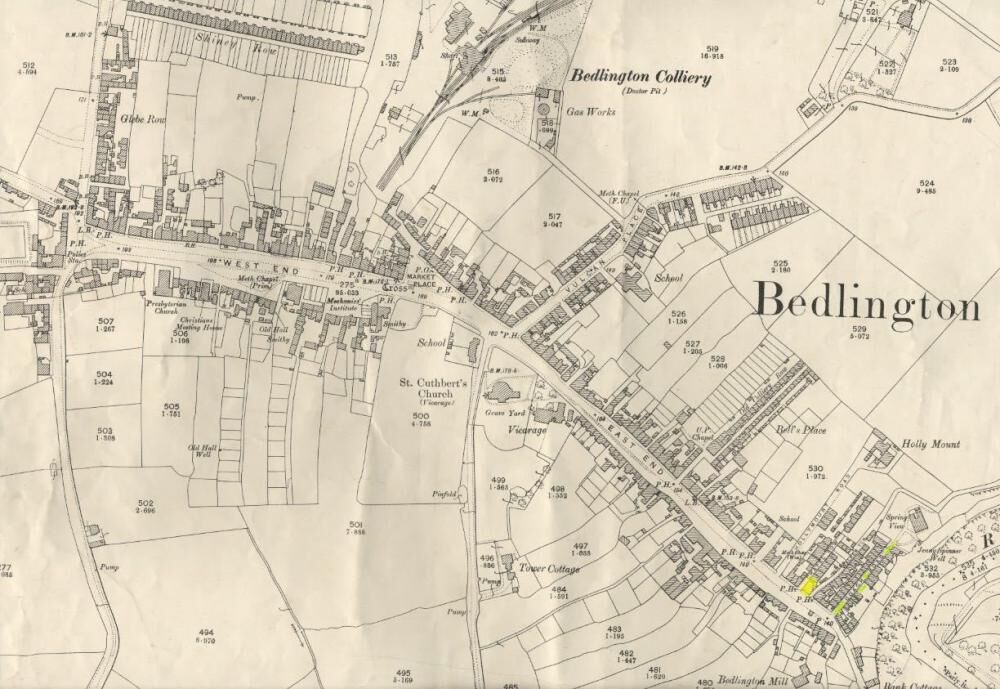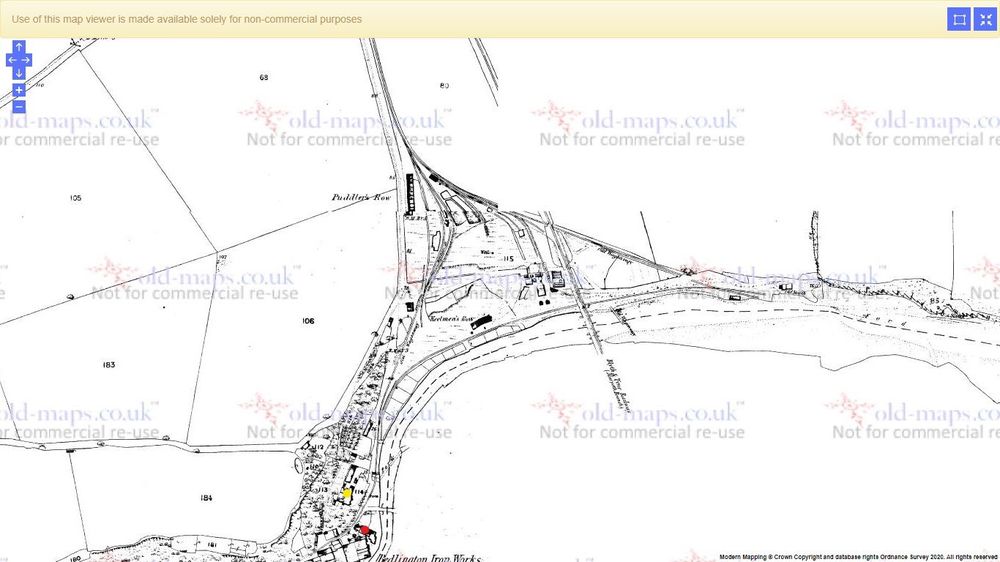.jpg.cdd7f8371d17e2f2f2e2a0e21e02f727.jpg)
Canny lass
Supporting Members-
Posts
3,596 -
Joined
-
Last visited
-
Days Won
407
Content Type
Forums
Gallery
Events
Shop
News
Audio Archive
Timeline
Everything posted by Canny lass
-
-
... and, does anybody know anything about the "Lime Shed" to the rear of the building or the "footpath to station" shown bottom right?
-
I'm wondering if we have the right Mechanics Institute here? In 1860 the Bedlington Colliery Mechanics Institute was in the Market Place, a stones throw from the pit.
-
I agree wholeheartedly! The right hand side of Dene House is much earlier than the left which is why I said it may be an extension to an earlier building. It’s interesting to learn that the house had a stable. Could that have become the office block? That building, as can be seen from the photo has undergone several changes: The central, upstairs window has been removed and the two doors are a later addition as evidenced by the dividing upright and lintels, which seem to be much newer than the window lintels. It’s possible this has been an archway, wide enough for a carriage, leading to a small stable yard – possibly the walled area behind and to the side of the house with a single storey covered area on the side nearest the river, as shown in the first photo. It wasn’t uncommon to find married accommodation above the stables, which would explain the windows. I might add, that the advert you mention states that there are 80 years left on the lease, suggesting that the house is about 20 years old in 1757 (Leasehold is generally 99 years).
-
You are so good at this 'colouring in' thing! You should give classes.
-
Evans says that the photo shows some of the old ironworks "office" buildings and office accomodation seems like a reasonable description looking at its placement as can be seen on various maps. The building was adjacent to the main body of the Ironworks while Dene House was set back a little from the work area. Both may have been built about the same time and that could account for the architectural similarities. They don't appear on a map of the area dated 1828 but both appear on a map of the railway sidings from 1859 and on subsequent OS maps. Dene House marked in yellow and office accommodation marked in red: It may be an extension to an already existing building. Its proximity to the work area is shown more clearly in this map from 1869 ( but nothing seems to have changed) You can see it is only a few steps away from the work area and it's also worth noting that the main entrance to the building faces the Ironworks, not the bridge, so is presumably part of the Ironworks.
-
This weeks quiz: Ready, steady go! 1. From which language does the word ketchup come? 2. Of which country was Pakistan part until 1947? 3. Which high - jumper used his flop technique to win the high jump at the 1968 Olympics? 4. Kelts, alevins and grilse are all forms of what? 5. Which English girls name means ‘strange’ or ‘foreign’ in Greek? 6. In which sport can you find something named after Ulrich Salchow? 7. In the Tarzan novels who was known as Korak? 8. What is the capital of the Philipines? 9. Elvis Presley had three successive No 1 hits in the UK charts in 1961. Name one? 10. Which London monument was cast from the guns recovered from the wreck of the Royal George? 11. What was a bridewell? 12. Which unit of measurement was based on the distance from the elbow to the tip of the middle finger? Bonus question for 10 points: The dividing line between genius and insane is a very fine one. On which side of the line do we find Donald Trump? I’ll bet you didn’t know …. Each day is longer than the previous one by 0.00000002 seconds, which works out to be 13 seconds each century.
-
.thumb.jpg.7493ddab4a696108cf2b849323d3c155.jpg)
Market Place.jpg
Canny lass commented on Alan Edgar (Eggy1948)'s gallery image in Historic Bedlington
Good photo, Jammy! There's no doubt in my mind that the space you ask about is the site of the toilet block, Eggy. That curved wall to the left formed one wall of the passage way to the Ladies entrance. The toilet building formed the other. I only ever used those toilets once and never again! Not because of any fault with the toilet facilities themselves but because of the huge amount of the biggest black slugs i've ever seen that invaded that passageway. The wall was covered in them of an evening. It was always dark and damp in there so they probably thrived. I didn't even like standing at the bus-stop if I had to stand too near the entrance. I think I just make out the curve of the wall in Jammy's photo. -
I suggest having a closer look at the census records JayDe. Maybe you'll recognise some of the other names at these addresses.
-
-
.thumb.jpg.7493ddab4a696108cf2b849323d3c155.jpg)
Market Place.jpg
Canny lass commented on Alan Edgar (Eggy1948)'s gallery image in Historic Bedlington
-
Another mystery solved!
-
Only 1 left now but I've just ordered it! Thanks!
-
Impressive collection! I'll have a look for the book on't net.
-
Nice and easy this week! 1. Who performed the theme song in the James Bond film Thunderball? 2. What is the capital of the Dominican Republic? 3. What is an odalisque? 4. Which of Henry VIII’s wives is buried alongside him at Windsor? 5. In which country does the Amazon river meet the sea? 6. Which sport was played by Peanut Louie? 7. Which bird has the scientific name Troglodytes Troglodytes? 8. Which David presented Juke Box Jury? 9. Which Sunday newspaper first hit the streets of London in 1843? 10. From which animal did Jenner develop his smallpox vaccine? 11. What name is given to words such as deed, minim, madam and rotavator? 12. What makes stainless steel stainless? I’ll bet you didn’t know …. An iceberg bigger than Belgium was seen in the southern Pacific Ocean in 1956.
-
Much better photo! Don't recognise any of those names. Is that book any good? Worth having in my collection?
-
.thumb.jpg.7493ddab4a696108cf2b849323d3c155.jpg)
Help please re smell/deceased animal next door
Canny lass replied to Sarah Gordon's topic in Talk of the Town
It may be gone but it's still left a very bad smell ... coming from environmental health - who didn't offer any help! Same on them! -
.thumb.jpg.7493ddab4a696108cf2b849323d3c155.jpg)
The Netherton Family Treer by Jack Black
Canny lass replied to Alan Edgar (Eggy1948)'s topic in History Hollow
I have a photographed copy of this taken from a book ( I don't know which book), pages 85 - 106, by "John Edward Fitzgerald Black b. Netherton Colliery 9.2.1915 d. Bedlington 28.3.92". I've no idea where I got it from. Perhaps the typewritten is the original. That's definitely my family on page 3 -
It's Friday! Let battle commence! Choice of weapons - Google at 10 paces: 1. How many days does a broody hen sit on her eggs? 2. What would a cooper make for you? 3. Which British monarch’s dying words were “All my possessions for a moment of time”? 4. Who won the Monaco Grand Prix in 1996? 5. Which city is served by Hopkins Airport? 6. What is the currency in Iraq? 7. In which city is the Embassy World Snooker Championship held? 8. Who played the title role in the1966 film Alfie?? 9. What is a gibus? 10. Which singing voice is between tenor and soprano? 11. What is Fred Flintstone’s daughter called? 12. Which organization has twice won the Nobel Peace Prize? I’ll bet you didn’t know …. In November 1960 an American rocket, launched from Cape Canaveral, went off course and crashed in Cuba killing a cow.


.jpg.d9f9f19e392e775b4dee8c40de5dfe33.jpg)


_LI.thumb.jpg.0356844c1f365122098112aea349b934.jpg)


